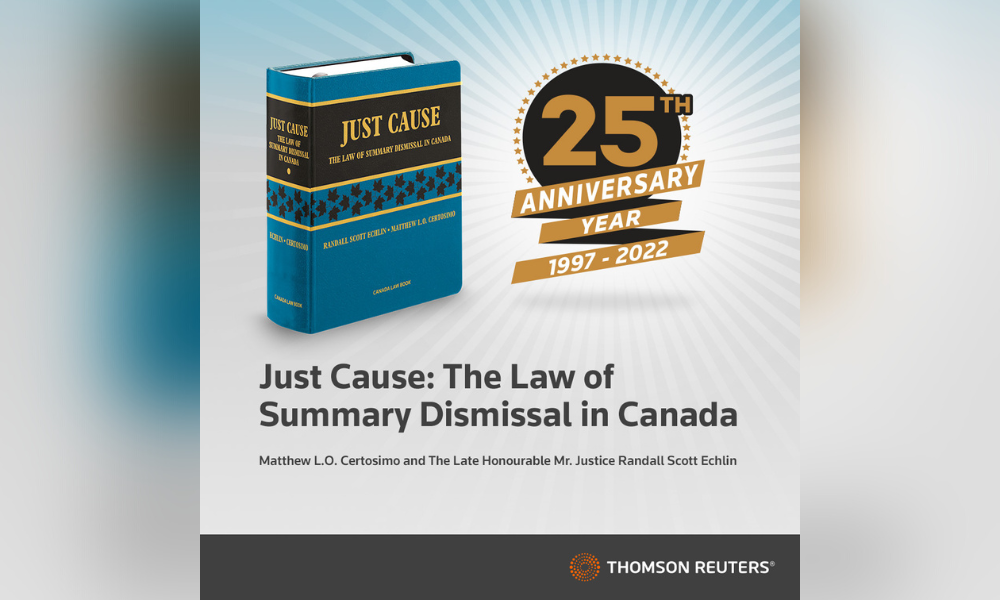
Whatever the case, when it comes to just cause an employer needs to tread carefully

What does and doesn’t constitute just cause in the workplace has always been a complex and ever-evolving topic – just ask Matthew Certosimo, partner at Borden Ladner Gervais LLP. His renowned book, Just Cause: The Law of Summary Dismissal in Canada, which was originally co-authored with the late Justice Echlin, recently celebrated its 25th anniversary. And it just so happens that February 4th 1998, the day the hard copies finally arrived at his office, holds a doubly special meaning for Certosimo.
Read more: Mining for success: BHP Billiton’s global HR strategy
“I like to think of that date as holding two very important anniversaries,” he told HRD. “When the books arrived at BLG, I was actually at the hospital with my wife as she gave birth to our twin daughters. We like to joke that three babies arrived that day.”
With this book, Certosimo explained, it was his late co-author’s vision to fully explore the doctrine of just cause, in the hopes of clarifying the murky laws around just cause – which surprisingly, when the book was first penned, didn’t really exist.
“When Randy Echlin invited me to write the book with him, there wasn’t a legal text specifically on just cause. He thought that there should be an authoritative, comprehensive text that was useful to lawyers, the courts, human resource professionals, employers, and employees alike,” he added. “And so we really wanted to clarify the historic legal doctrine known as the capital punishment of employment law. We looked at its origins in contract law and in common law, which evolved in part from the doctrine of repudiation. However, in the employment relationship, it takes on a very different and very human meaning. At the time, there was a lot of uncertainty around the edges as to how the doctrine should apply in the workplace.”
Read more: McDonald's director of people strategy on thriving in a pandemic
Sometime after the publication of Certosimo’s book, the Supreme Court of Canada weighed in with a case called McKinley, which involved alleged dishonesty by an employee in British Columbia. The question was whether the British Columbia “dishonesty is always just cause” line of cases should prevail or if the contextual line of cases from elsewhere in Canada should carry the day. The Supreme Court of Canada determined that context matters and not just to dishonesty, but to all just cause cases. In McKinley, the Supreme Court also adopted the principle of proportionality, meaning that employers should also weigh whether the capital punishment of the employment relationship is the appropriate remedy, all things considered. Now, courts across Canada routinely apply the McKinley doctrine.
“In some areas we've seen evolution and clarity over the years since Just Cause was published, such as with McKinley, but there are other areas where it still remains a little muddy,” Certosimo explained. “For example, while the publisher was getting the book ready for distribution 25 years ago, the Supreme Court of Canada issued a brief judgment in Dowling, which made it very clear that there is no doctrine of “near cause” – either the employer has just cause or the dismissal is without cause and the employee is entitled to a full severance package. So, we had to quickly re-write sections of the chapter on Near Cause.”
But, Certosimo adds, other areas of the law are still a work in progress: “Whether or not an employer must provide an employee with an opportunity to address allegations of cause before dismissal is an example of an area that has received some mixed treatment, over the years. Historically the case law was very clear on the concept of the so-called ‘master servant’ relationship – which was such that an employer had no such obligation to give an employee a chance to respond to allegations before coming to a conclusion that the employee should be terminated. It was noted that the doctrine of after-acquired cause was a logical extension of that thinking. For the most part, such as in an Alberta case called Leach, our courts have not adopted an implied obligation to provide an internal chance to respond process. Yet, this area may very well continue to evolve.”
Whatever the case, when it comes to just cause an employer needs to tread carefully. Certosimo, believes the biggest mistake an HR leader can make in these situations is acting too quickly – and not doing their proper due diligence.
“I think employers should act with haste, but not hastily,” added Certosimo. “Start by getting the facts straight. Preserve the evidence. Ask the accused wrongdoer for their side of the story – there’s nothing to lose in doing so. Then, assess any wrongdoing in context - for example, length of service, disciplinary record, employee duties, workplace norms. And, lastly, consider whether discipline short of summary dismissal would be the proportional response, particularly when dealing with an isolated incident.”
On the 25th anniversary of Just Cause, Certosimo was reflective: “Randy Echlin was the high-profile lawyer sought out by publishers; I was the rookie – a junior associate. He had the vision, and I thank my lucky stars that he invited me to execute on it. In the 25 years since, with annual updates to the book and so on, I have had a front-row seat in such an important part of our employment law.”
Purchase a copy of Just Cause: The Law of Summary Dismissal in Canada here.